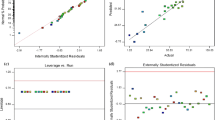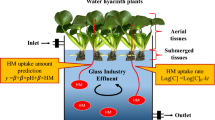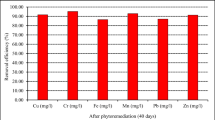Abstract
The present study aimed to assess the efficiency of the water hyacinth (Eichhornia crassipes (Mart.) Solms) plant for the reduction of nitrogen and phosphorus pollutants from glass industry effluent (GIE) as batch mode phytoremediation experiments. For this, response surface methodology (RSM) and artificial neural networks (ANN) methods were adopted to evidence the optimization and prediction performances of E. crassipes for total Kjeldahl’s nitrogen (TKN) and total phosphorus (TP) removal. The control parameters, i.e., GIE concentration (0, 50, and 100%) and plant density (1, 3, and 5 numbers) were used to optimize the best reduction conditions of TKN and TP. A quadratic model of RSM and feed-forward backpropagation algorithm-based logistic model (input layer: 2 neurons, hidden layer: 10 neurons, and output layer: 1 neuron) of ANN showed good fitness results for experimental optimization. Optimization results showed that maximum reduction of TKN (93.86%) and TP (87.43%) was achieved by using 60% of GIE concentration and nearly five plants. However, coefficient of determination (R2) values showed that ANN models (TKN: 0.9980; TP: 0.9899) were superior in terms of prediction performance as compared to RSM (TKN: 0.9888; TP: 0.9868). Therefore, the findings of this study concluded that E. crassipes can be effectively used to remediate nitrogen and phosphorus loads of GIE and minimize environmental hazards caused by its unsafe disposal.



Similar content being viewed by others
Data availability
The datasets generated during and/or analyzed during the current study are available from the corresponding author upon reasonable request.
References
Adelodun AA, Olajire T, Afolabi NO et al (2021) Phytoremediation potentials of Eichhornia crassipes for nutrients and organic pollutants from textile wastewater. Int J Phytorem 23:1333–1341. https://doi.org/10.1080/15226514.2021.1895719
Adeniran KA, Adelodun B, Ogunshina M (2016) Biocheminio deguonies suvartojimo ir ištirpusio deguonies kiekio upėse modeliavimas naudojant dirbtinius neuroninius tinklus: Asos upės atvejo studija. Environ Res Eng Manag 72:59–74. https://doi.org/10.5755/j01.erem.72.3.14120
Alam R, Khan SU, Basheer F, Farooqi IH (2021) Nutrients and organics removal from slaughterhouse wastewater using phytoremediation: a comparative study on different aquatic plant species. IOP Conference Series: Materials Science and Engineering 1058:012068. https://doi.org/10.1088/1757-899x/1058/1/012068
Ali S, Abbas Z, Rizwan M et al (2020) Application of floating aquatic plants in phytoremediation of heavy metals polluted water: a review. Sustainability (switzerland) 12:1927. https://doi.org/10.3390/su12051927
Anand S, Bharti SK, Kumar S, Barman S, Kumar N (2019) Phytoremediation of heavy metals and pesticides present in water using aquatic macrophytes. In: Arora, N., Kumar, N. (eds) Phyto and rhizo remediation. Microorganisms for sustainability, vol 9. Springer, Singapore. https://doi.org/10.1007/978-981-32-9664-0_4
APHA (2012) Standard methods for the examination of water and wastewater standard methods for the examination of water and wastewater. American Public Health Association (APHA), Washington, DC
Ceschin S, Crescenzi M, Iannelli MA (2020) Phytoremediation potential of the duckweeds Lemna minuta and Lemna minor to remove nutrients from treated waters. Environ Sci Pollut Res 27(13):15806–15814. https://doi.org/10.1007/s11356-020-08045-3
Eid EM, Shaltout KH, Moghanm FS et al (2019) Bioaccumulation and translocation of nine heavy metals by eichhornia crassipes in Nile delta, Egypt: perspectives for phytoremediation. Int J Phytorem 21:821–830. https://doi.org/10.1080/15226514.2019.1566885
Eid EM, Galal TM, Sewelam NA et al (2020) Phytoremediation of heavy metals by four aquatic macrophytes and their potential use as contamination indicators: a comparative assessment. Environ Sci Pollut Res 27:12138–12151. https://doi.org/10.1007/s11356-020-07839-9
Freestone IC (1991) Looking into glass. New Zealand Geographic
Gavrilescu M, Demnerová K, Aamand J et al (2015) Emerging pollutants in the environment: present and future challenges in biomonitoring, ecological risks and bioremediation. New Biotechnol 32:147–156. https://doi.org/10.1016/j.nbt.2014.01.001
Gholipour A, Zahabi H, Stefanakis AI (2020) A novel pilot and full-scale constructed wetland study for glass industry wastewater treatment. Chemosphere 247:125966. https://doi.org/10.1016/j.chemosphere.2020.125966
Goala M, Yadav KK, Alam J et al (2021) Phytoremediation of dairy wastewater using Azolla pinnata: application of image processing technique for leaflet growth simulation. Journal of Water Process Engineering 42:102152. https://doi.org/10.1016/j.jwpe.2021.102152
Guignard MS, Leitch AR, Acquisti C et al (2017) Impacts of nitrogen and phosphorus: from genomes to natural ecosystems and agriculture. Front Ecol Evol 5:70. https://doi.org/10.3389/fevo.2017.00070
Hualpa-Cutipa E, Acosta RAS, Sangay-Tucto S, Beingolea XGM, Gutierrez GT, Zabarburú IN (2022). Recent trends for treatment of environmental contaminants in wastewater: An integrated valorization of industrial wastewater. In Integrated Environmental Technologies for Wastewater Treatment and Sustainable Development. Elsevier, pp 337–368
Jaskulak M, Grobelak A, Vandenbulcke F (2020) Modeling and optimizing the removal of cadmium by Sinapis alba L. from contaminated soil via response surface methodology and artificial neural networks during assisted phytoremediation with sewage sludge. Int J Phytorem 22:1321–1330. https://doi.org/10.1080/15226514.2020.1768513
Kumar S, Khapre A (2017) Phytocapping technology for sustainable management of landfill sites Phytoremediation Environ Pollut 413–420. https://doi.org/10.4324/9781315161549
Kumar D, Sharma C (2019) Remediation of pulp and paper industry effluent using electrocoagulation process. J Water Resour Prot 11:296–310. https://doi.org/10.4236/jwarp.2019.113017
Kumar M, Singh R (2019) Assessment of pollutant removal processes and kinetic modelling in vertical flow constructed wetlands at elevated pollutant loading. Environ Sci Pollut Res 26:18421–18433. https://doi.org/10.1007/s11356-019-05019-y
Kumar V, Singh J, Chopra AK (2018) Assessment of plant growth attributes, bioaccumulation, enrichment, and translocation of heavy metals in water lettuce (Pistia stratiotes L.) grown in sugar mill effluent. Int J Phytorem 20:507–521. https://doi.org/10.1080/15226514.2017.1393391
Kumar V, Singh J, Kumar P, Kumar P (2019) Response surface methodology based electro-kinetic modeling of biological and chemical oxygen demand removal from sugar mill effluent by water hyacinth (Eichhornia crassipes) in a Continuous Stirred Tank Reactor (CSTR). Environ Technol Innov 14:100327. https://doi.org/10.1016/j.eti.2019.100327
Kumar D, Malyan SK, Kumar A, Kumar J (2021a) Microbiological removal of heavy metals from the environment Nanobiotechnol Green Environ 139–164. https://doi.org/10.1201/9780367461362-6
Kumar SS, Rai A, Singh R, Kumar V, Kumar D, Kumar J, Kumar A, Malyan SK (2021b) Bioelectroremediation technologies in remediation of environmental pollutants: challenges and future prospects. In: Kumar GS, Shah MP (eds) Bioremediation for environmental sustainability. Elsevier, Bioremediation for environmental sustainability, pp 147–165
Malyan SK, Singh R, Rawat M et al (2019) An overview of carcinogenic pollutants in groundwater of India. Biocatal Agric Biotechnol 21:101288. https://doi.org/10.1016/j.bcab.2019.101288
Malyan SK, Kumar SS, Singh L, et al (2021a) Bioelectrochemical systems for removal and recovery of heavy metals. In: Bioremediation, Nutrients, and Other Valuable Product Recovery. pp 185–203
Malyan SK, Yadav S, Sonkar V, Goyal VC, Singh O, Singh R (2021b) Mechanistic understanding of the pollutant removal and transformation processes in the constructed wetland system. Water Environ Res 93:1882–1909. https://doi.org/10.1002/wer.1599
Mohammadi F, Samaei MR, Azhdarpoor A et al (2019) Modelling and optimizing pyrene removal from the soil by phytoremediation using response surface methodology, artificial neural networks, and genetic algorithm. Chemosphere 237:6. https://doi.org/10.1016/j.chemosphere.2019.124486
Mustafa HM, Hayder G (2021) Recent studies on applications of aquatic weed plants in phytoremediation of wastewater: a review article. Ain Shams Eng J 12:355–365. https://doi.org/10.1016/j.asej.2020.05.009
Nwankwoala H, Omofuophu E (2019) Modeling and assessment of human health risks from exposure to hydrocarbon contaminated soils in parts of Bonny, Rivers State, Nigeria. SF J Env Earth Sci 2:1–7
Nwogwu NA, Ajala OA, Ajibade FO, Ajibade TF, Adelodun B, Lasisi KH, Ugya AY, Kumar P, Omotade IF, Babalola TE, Adewumi JR (2021) Phytoremediation mechanisms of heavy metal removal: a step towards a green and sustainable environment. In: Innovative bio-based technologies for environmental remediation, 1st edn. CRC Press, pp 1–30. https://doi.org/10.1201/9781003004684-11
OdedishemiAjibade F, Wang HC, Guadie A et al (2021) Total nitrogen removal in biochar amended non-aerated vertical flow constructed wetlands for secondary wastewater effluent with low C/N ratio: Microbial community structure and dissolved organic carbon release conditions. Biores Technol 322:124430. https://doi.org/10.1016/j.biortech.2020.124430
Rathi PM, Madan S (2019) Effect of glass industry effluent on seed germination and biochemical parameters of Glycine max (Soyabean). Agric Rev 53:468–472. https://doi.org/10.18805/ijare.a-5122
Sáez-Plaza P, Navas MJ, Wybraniec S et al (2013) An overview of the Kjeldahl method of nitrogen determination. Part II. Sample Preparation, Working Scale, Instrumental Finish, and Quality Control. Crit Rev Anal Chem 43:224–272. https://doi.org/10.1080/10408347.2012.751787
Sen S, Nandi S, Dutta S (2018) Application of RSM and ANN for optimization and modeling of biosorption of chromium(VI) using cyanobacterial biomass. Appl Water Sci 8:148. https://doi.org/10.1007/s13201-018-0790-y
Sharma R, Saini H, Paul DR, Chaudhary S, Nehra SP (2021) Removal of organic dyes from wastewater using Eichhornia crassipes: a potential phytoremediation option. Environ Sci Pollut Res 28(6):7116–7122. https://doi.org/10.1007/s11356-020-10940-8
Shen LQ, Amatulli G, Sethi T et al (2020) Estimating nitrogen and phosphorus concentrations in streams and rivers, within a machine learning framework. Scientific Data 7:161. https://doi.org/10.1038/s41597-020-0478-7
Shi H (2015) Practice and innovation of discharge standard of water pollutants in North China. Environ Sustain Dev 1:68–71. https://doi.org/10.3969/j.issn.1673-288X.2015.01.016
Shikha S, Gauba P (2016) Phytoremediation of industrial and pharmaceutical pollutants. Recent Adv Biol Med 2:113. https://doi.org/10.18639/rabm.2016.02.341789
Singh J, Kumar V, Kumar P, Kumar P, Yadav KK, Cabral‐Pinto MM, Kamyab H, Chelliapan S (2021a) An experimental investigation on phytoremediation performance of water lettuce (Pistia stratiotes L.) for pollutants removal from paper mill effluent. Water Environ Res 93(9):1543–1553
Singh J, Kumar V, Kumar P, Kumar P (2021b) Kinetics and prediction modeling of heavy metal phytoremediation from glass industry effluent by water hyacinth (Eichhornia crassipes). Int J Environ Sci Technol 19:5481–5492 (2022). https://doi.org/10.1007/s13762-021-03433-9
Sood A, Uniyal PL, Prasanna R, Ahluwalia AS (2012) Phytoremediation potential of aquatic macrophyte, Azolla. Ambio 41:122–137. https://doi.org/10.1007/s13280-011-0159-z
Sricoth T, Meeinkuirt W, Pichtel J, Taeprayoon P, Saengwilai P (2018) Synergistic phytoremediation of wastewater by two aquatic plants (Typha angustifolia and Eichhornia crassipes) and potential as biomass fuel. Environ Sci Pollut Res 25(6):5344–5358. https://doi.org/10.1007/s11356-017-0813-5
Varma M, Gupta AK, Ghosal PS, Majumder A (2021) A review on performance of constructed wetlands in tropical and cold climate: insights of mechanism, role of influencing factors, and system modification in low temperature. Sci Total Environ 755:14254. https://doi.org/10.1016/j.scitotenv.2020.142540
Varun M, D’Souza R, Pratas J, Paul MS (2012) Metal contamination of soils and plants associated with the glass industry in North Central India: Prospects of phytoremediation. Environ Sci Pollut Res 19:269–281. https://doi.org/10.1007/s11356-011-0530-4
Webb JM, Quintã R, Papadimitriou S et al (2013) The effect of halophyte planting density on the efficiency of constructed wetlands for the treatment of wastewater from marine aquaculture. Ecol Eng 61:145–153. https://doi.org/10.1016/j.ecoleng.2013.09.058
Wei Z, van Le Q, Peng W et al (2021) A review on phytoremediation of contaminants in air, water and soil. J Hazard Mater 403:123658. https://doi.org/10.1016/j.jhazmat.2020.123658
Worsfold P, Gimbert L, Mankasingh U et al (2005) Sampling, sample treatment and quality assurance issues for the determination of phosphorus species in natural waters and soils. Talanta 66:273–293. https://doi.org/10.1016/j.talanta.2004.09.006
Xu H-S, Zhu L, Mei Y (2021) Effects of high levels of nitrogen and phosphorus on perennial ryegrass (Lolium perenne L.) and its potential in bioremediation of highly eutrophic water. Environ Sci Pollut Res 28:9475–9483. https://doi.org/10.1007/s11356-020-11458-9
Yang ZH, Lien PJ, Huang WS et al (2017) Development of the risk assessment and management strategies for TPH-contaminated sites using TPH fraction methods. J Hazard Toxic Radioact Waste 21:15003–15010. https://doi.org/10.1061/(asce)hz.2153-5515.0000290
Acknowledgements
The authors are thankful to the Gurukula Kangri (Deemed to be University) for providing the necessary experimental facilities. Mostafa A. Taher extends his appreciation to King Khalid University for funding this work through the Research Group Project under grant number RGP. 1/182/43; The author (Hanan E. M. Osman) would like to thank the Deanship of Scientific Research at Umm Al-Qura University for supporting this work by Grant Code: (22UQU4320730DSR05), Makkah, Saudi Arabia.
Funding
This research was funded by King Khalid University (grant number RGP. 1/182/43), Abha, Saudi Arabia; and Umm-Al-Qura University (grant code 22UQU4320730DSR05), Makkah, Saudi Arabia.
Author information
Authors and Affiliations
Contributions
All authors contributed to the study’s conception and design. Material preparation, data collection, and analysis were performed by Jogendra Singh and Pankaj Kumar. The first draft of the manuscript was written by Jogendra Singh and Pankaj Kumar and all authors commented on previous versions of the manuscript. Vinod Kumar supervised the work and provided resources. Ebrahem M. Eid managed the project administration, visualization, data curation and supervision. Mostafa A. Taher, Mohamed H.E. El-Morsy, Hanan E.M. Osman, and Dhafer A. Al-Bakre validated the work. All authors read and approved the final manuscript.
Corresponding author
Ethics declarations
Ethics approval.
This article does not contain any studies with human participants or animals.
Consent to participate.
All authors mutually agreed to participate in this work.
Consent for publication.
All authors mutually agreed to publish the work.
Competing interests
The authors declare no competing interests.
Additional information
Responsible Editor: Elena Maestri
Publisher's note
Springer Nature remains neutral with regard to jurisdictional claims in published maps and institutional affiliations.
Statement of novelty
Being extremely toxic, there are limited adopted methods for the glass industry effluent treatment. The current study emphasized plant-assisted phyto-treatment of nitrogen and phosphorus pollutants from glass industry effluent. Work focuses on the design and development of response surface methodology (RSM) and artificial neural network (ANN) models-based phytoremediation experiments for efficient reduction and optimization of total Kjeldahl nitrogen (TKN) and total phosphorus (TP) pollutants. The findings reported in this study are novel that could help in the sustainable upcycling of industrial effluent using green technology.
Rights and permissions
Springer Nature or its licensor holds exclusive rights to this article under a publishing agreement with the author(s) or other rightsholder(s); author self-archiving of the accepted manuscript version of this article is solely governed by the terms of such publishing agreement and applicable law.
About this article
Cite this article
Singh, J., Kumar, P., Eid, E.M. et al. Phytoremediation of nitrogen and phosphorus pollutants from glass industry effluent by using water hyacinth (Eichhornia crassipes (Mart.) Solms): Application of RSM and ANN techniques for experimental optimization. Environ Sci Pollut Res 30, 20590–20600 (2023). https://doi.org/10.1007/s11356-022-23601-9
Received:
Accepted:
Published:
Issue Date:
DOI: https://doi.org/10.1007/s11356-022-23601-9




